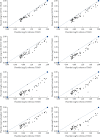Masking Ability of Various Metal Complexing Ligands at 1.0 mM Concentrations on the Potentiometric Determination of Fluoride in Aqueous Samples
- PMID: 33381350
- PMCID: PMC7762639
- DOI: 10.1155/2020/6683309
Masking Ability of Various Metal Complexing Ligands at 1.0 mM Concentrations on the Potentiometric Determination of Fluoride in Aqueous Samples
Abstract
Fluoride is a common anion present in natural waters. Among many analytical methods used for the quantification of fluoride in natural waters, potentiometric analysis is one of the most widely used methods because of minimum interferences from other ions commonly present in natural waters. The potentiometric analysis requires the use of ionic strength adjusting buffer abbreviated as TISAB to obtain accurate and reproducible data. In most of the reported literature, higher concentrations of strong metal chelating ligands are used as masking agents generally in the concentration range of 1.0 to 0.01 M. In the present study, effectiveness of the masking agents, phosphate, citrate, CDTA ((1,2-cyclohexylenedinitrilo)tetraacetic acid), EDTA (ethylenediaminetetraacetic acid) HE-EDTA ((hydroxyethyl)ethylenediaminetriacetic acid)), triethanolamine, and tartaric acid at 1.0 mM in TISAB solutions was investigated. The experimental data were compared with a commercially available WTW 140100 TISAB solution as the reference buffer. According to the experimental data, the reference buffer always produced the highest fluoride concentrations and the measured fluoride concentrations were in the range of 0.611 to 1.956 mg/L. Out of all the masking agents investigated, only CDTA performed marginally well and approximately a quarter of the samples produced statistically comparable data to the reference buffer. All the other masking agents produced significantly low concentrations compared to the reference buffer. The most probable reasons for the underestimation of fluoride concentrations could be shorter decomplexing time and lower masking agent concentrations.
Copyright © 2020 Sakuni M. De Silva et al.
Conflict of interest statement
The authors declare that they have no conflicts of interest.
Figures
Similar articles
-
The determination of fluoride in water in the presence of organic acids and iron using a fluoride-selective electrode.Environ Geochem Health. 1993 Sep;15(2-3):185-6. doi: 10.1007/BF02627837. Environ Geochem Health. 1993. PMID: 24198115
-
Aluminum ions in analysis of released fluoride from glass ionomers.J Dent. 1997 Mar;25(2):137-44. doi: 10.1016/s0300-5712(96)00021-8. J Dent. 1997. PMID: 9105145
-
Determination of fluoride in natural waters by ion-selective electrode potentiometry after co-precipitation with aluminium phosphate.Talanta. 1989 Oct;36(10):973-6. doi: 10.1016/0039-9140(89)80177-8. Talanta. 1989. PMID: 18964846
-
Determination of fluoride using ion-selective electrodes in the presence of aluminum.Anal Sci. 2009 Dec;25(12):1437-43. doi: 10.2116/analsci.25.1437. Anal Sci. 2009. PMID: 20009331
-
Environmental fate of EDTA and DTPA.Rev Environ Contam Toxicol. 1997;152:85-111. doi: 10.1007/978-1-4612-1964-4_3. Rev Environ Contam Toxicol. 1997. PMID: 9297986 Review.
Cited by
-
Determination of Fluorine by Ion-Selective Electrode and High-Resolution Continuum Source Graphite Furnace Molecular Absorption Spectrometry with Respect to Animal Feed Safety.Materials (Basel). 2024 Jun 9;17(12):2812. doi: 10.3390/ma17122812. Materials (Basel). 2024. PMID: 38930182 Free PMC article.
-
Determination of Calcium in Meat Products by Automatic Titration with 1,2-Diaminocyclohexane-N,N,N',N'-tetraacetic Acid.Molecules. 2023 Sep 13;28(18):6592. doi: 10.3390/molecules28186592. Molecules. 2023. PMID: 37764368 Free PMC article.
References
-
- Edmunds W. M., Smedley P. L. Fluoride in natural waters. Essentials of Medical Geology. 2013;13:311–336. doi: 10.1007/978-94-007-4375-5. - DOI
-
- Dissanayake C. B. Water quality in the dry zone of Sri Lanka - some interesting health aspects. Journal of the National Science Foundation of Sri Lanka. 2005;33(3):161–168. doi: 10.4038/jnsfsr.v33i3.2322. - DOI
-
- Chandrajith R., Padmasiri J. P., Dissanayake C. B., Prematilaka K. M. Spatial distribution of fluoride in groundwater of Sri Lanka. Journal of the National Science Foundation of Sri Lanka. 2012;40(4):303–309. doi: 10.4038/jnsfsr.v40i4.5044. - DOI
-
- Ali S., Thakur S. K., Sarkar A., Shekhar S. Worldwide contamination of water by fluoride. Environmental Chemistry Letters. 2016;14(3):291–315. doi: 10.1007/s10311-016-0563-5. - DOI
LinkOut - more resources
Full Text Sources


